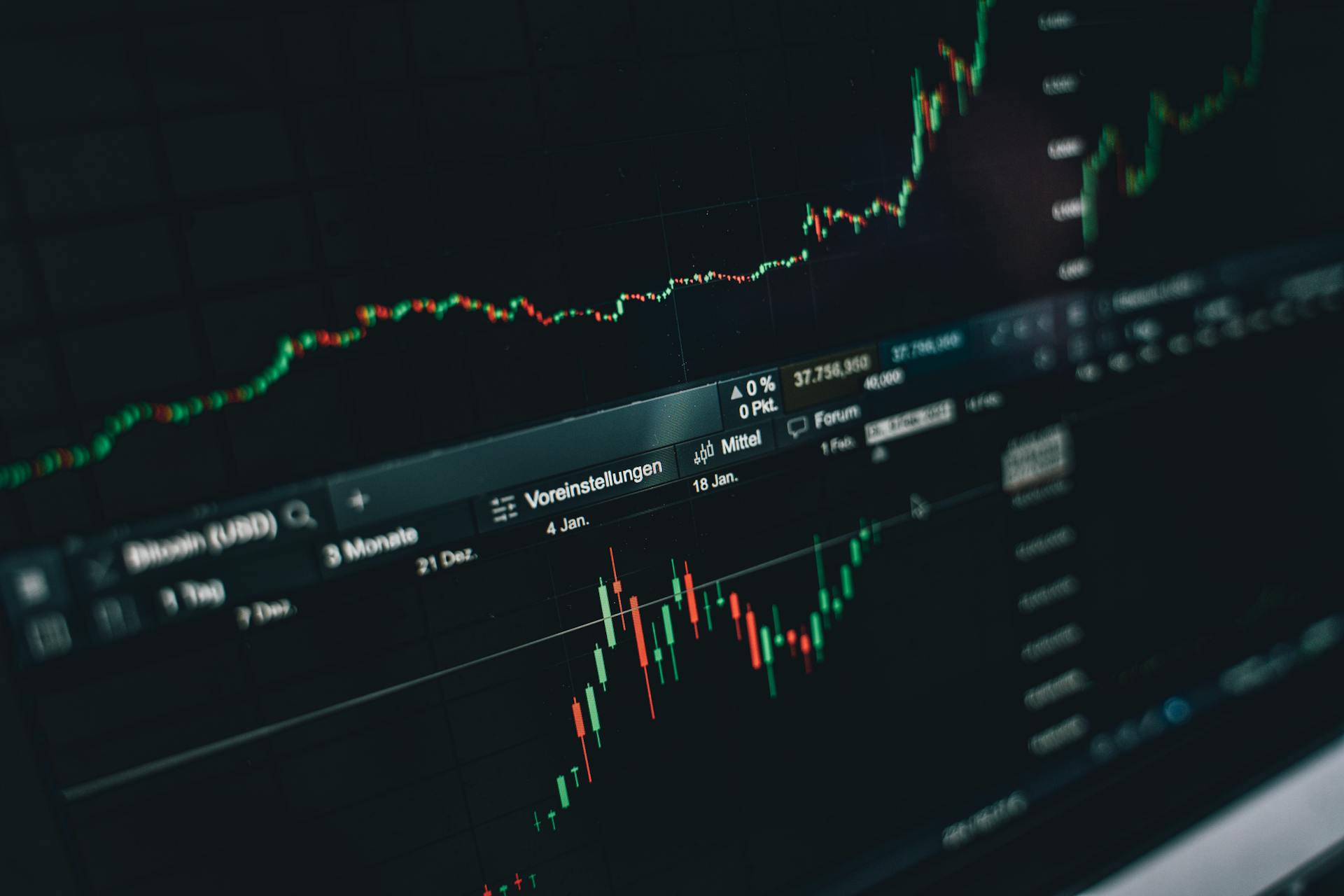
Value at risk modeling is a crucial tool for financial institutions to manage risk and make informed decisions. It helps estimate the potential loss of a portfolio over a specific time horizon with a given probability.
The goal of value at risk modeling is to quantify the potential loss, not to predict future market movements. This is achieved by analyzing historical data and identifying patterns and correlations.
A common approach to value at risk modeling is the variance-covariance method, which is based on the assumption that returns are normally distributed. This method is widely used due to its simplicity and computational efficiency.
Value at risk modeling can be used for various types of risk, including market risk, credit risk, and operational risk.
Expand your knowledge: Chain Ladder Method
What is Value at Risk
Value at risk (VaR) is the smallest number of financial loss that a certain percentage of bad events will not exceed. It's a measure of risk that's widely used in finance.
VaR is not a coherent risk measure, meaning it doesn't always behave as expected when combined with other measures. For example, it can be affected by the sub-additivity property, which states that the total risk of two separate investments should be less than or equal to the sum of their individual risks.
VaR is often used in conjunction with other risk measures, such as Conditional Value-at-Risk (CVaR) or entropic value at risk (EVaR), which are coherent and can bound VaR. CVaR, in particular, is defined as the average of VaR values for confidence levels between 0 and α.
VaR has some useful properties, such as being a robust statistic, meaning it's less affected by extreme values in the data. However, it's not suitable for all situations, especially when dealing with undefined losses or illiquid markets.
In mathematical terms, VaR can be defined as the (1-α)-quantile of the distribution of financial losses, where α is the confidence level. However, this formula can't be used directly for calculations unless we assume a specific distribution for the losses.
VaR can also be written as a distortion risk measure, using a distortion function that maps the probability distribution of losses to a new distribution. This can be useful for handling undefined losses or illiquid markets, but it requires careful consideration of the underlying assumptions.
VaR is used in a variety of fields, including actuarial science, financial risk modeling, market risk, Monte Carlo methods in finance, and credit risk.
A different take: The Biggest Risk Is Not Taking Any Risk
Types of Value at Risk
Value at Risk (VaR) is a complex concept with multiple interpretations. There are two broad types of VaR: one used primarily in risk management and the other primarily for risk measurement.
In risk management, VaR is a system that is run periodically, usually daily, and the published number is compared to the computed price movement in opening positions over the time horizon. This system is often used for making short-term and tactical decisions in the present.
Risk measurement VaR, on the other hand, is a number that is needed, not a system. It's a Bayesian probability claim that given the information and beliefs at the time, the subjective probability of a VaR break was the specified level.
VaR is adjusted after the fact to correct errors in inputs and computation, but not to incorporate information unavailable at the time of computation. This type of VaR is often used for understanding the past and making medium-term and strategic decisions for the future.
Suggestion: Time at Risk
In practice, many financial institutions use a hybrid version of VaR that incorporates elements of both risk management and risk measurement. This approach is useful for financial control and financial reporting.
Here are the main differences between risk management VaR and risk measurement VaR:
- Risk management VaR: system-based, used for short-term decisions, and published number is compared to actual price movements.
- Risk measurement VaR: number-based, used for understanding the past and making medium-term decisions, and adjusted after the fact to correct errors.
It's worth noting that some sources may treat only one kind of VaR as legitimate, but most recent sources agree that risk management VaR is superior for making short-term and tactical decisions, while risk measurement VaR should be used for understanding the past and making medium-term and strategic decisions.
You might like: Rate Making
Value at Risk Calculation
Value at Risk calculation is a crucial step in value at risk modeling. It involves estimating the potential loss in a financial portfolio over a specified time period with a certain level of confidence.
There are three common methods for calculating Value at Risk: Historical Simulation, Variance-Covariance (Parametric), and Monte Carlo Simulation. The choice of method depends on the characteristics of the portfolio and the assumptions made.
See what others are reading: Historical Simulation (finance)
The Variance-Covariance approach assumes that returns are normally distributed and calculates VaR as a mean -1.65 * standard deviation for a 95% confidence level and mean -2.33* standard deviation for a 99% confidence level.
The Historical Simulation approach involves calculating returns, sorting them from worst to best, and then selecting the VaR based on a specific percentage of the total count.
VaR can be estimated using either parametric or non-parametric methods. Parametric methods, such as variance-covariance VaR, assume a specific distribution of returns, while non-parametric methods, like historical simulation VaR, do not make such assumptions.
A McKinsey report found that 85% of large banks use historical simulation to estimate VaR, while the remaining 15% use Monte Carlo methods.
For more insights, see: Non Standard Auto Insurance Florida
Mathematical Definition
The mathematical definition of Value at Risk (VaR) is the foundation of this risk management concept. It's the smallest number y such that the probability that the loss does not exceed y is at least 1 minus the confidence level.
VaR is defined as the (1 minus the confidence level) quantile of the loss distribution Y. This means that VaR is the value below which the loss distribution falls with a certain probability.
The loss distribution Y is defined as the negative of the profit and loss distribution X. This is a fundamental concept in VaR calculations, and it's essential to understand the relationship between profit and loss.
VaR can be written as a distortion risk measure using a specific distortion function. This function is defined as 0 if the loss is less than 1 minus the confidence level, and 1 if the loss is greater than or equal to 1 minus the confidence level.
Risk managers often assume that some fraction of bad events will have undefined losses, which can be due to various reasons such as market closure or illiquidity. This assumption is not always accepted by academics, who prefer to assume a well-defined distribution with fat tails.
For another approach, see: Profit Risk
Calculation
There are three common methods for calculating Value at Risk (VaR): Historical Simulation, Variance-Covariance (Parametric), and Monte Carlo Simulation.
Historical Simulation involves sorting historical returns from worst to best and calculating the VaR as the return corresponding to a certain percentage of the total count.
The Variance-Covariance method assumes that returns are normally distributed and calculates VaR as the mean minus a certain number of standard deviations, depending on the confidence level.
The 95% confidence level, for example, uses a figure of -1.65 standard deviations, while the 99% confidence level uses -2.33 standard deviations.
VaR can be estimated either parametrically or nonparametrically, with nonparametric methods including Historical Simulation and Resampled VaR.
Historical Simulation is a widely used method, employed by 85% of large banks, according to a McKinsey report.
The choice of return distribution affects the accuracy of VaR estimates, and non-normality in return distributions can be significant, especially during extreme market events.
Check this out: Bornhuetter Ferguson Method
Here are the key components of Value at Risk calculation:
- Return distribution
- Historical returns
- Variance-covariance matrix
- Confidence level
- Scaling methodology
Note that scaling methodologies can introduce model risk and should be carefully validated.
VaR can be bounded by coherent risk measures like Conditional Value-at-Risk (CVaR) or entropic value at risk (EVaR).
Here are some common VaR calculation methods:
- Historical Simulation: sorts historical returns and calculates VaR as the return corresponding to a certain percentage of the total count
- Variance-Covariance: assumes normal distribution and calculates VaR as the mean minus a certain number of standard deviations
- Monte Carlo Simulation: generates random scenarios and calculates VaR as the loss exceeded with a certain probability
Volatility Estimation
Volatility Estimation is a crucial step in Value at Risk calculations, reflecting the uncertainty and risk in financial markets.
Volatility is a measure of the degree of variation of a trading price series over time. It's a key input in VaR calculations.
Common methods for estimating volatility include historical volatility, which is based on past price movements. This method is straightforward, but it may not accurately capture future price movements.
Implied volatility, on the other hand, is derived from option prices and can provide a more forward-looking estimate of volatility. This method is useful for traders and investors who want to anticipate potential price movements.
Here's an interesting read: The Dhandho Investor the Low-risk Value Method to High Returns
Various statistical models are also used to estimate volatility, providing a more mathematical approach to this calculation. These models can be complex, but they can help to identify potential risks in a financial portfolio.
Volatility is a critical component of VaR calculations, and choosing the right method for estimating it is essential for accurate risk assessment.
You might enjoy: Pimco Models
Time Horizon
The time horizon is a critical component of Value at Risk (VaR) calculation, specifying the period over which the risk is being assessed. This can range from a single day to several months.
The choice of time horizon is crucial, as it influences the sensitivity of the VaR measure to market movements. A shorter time horizon will result in a more conservative estimate of VaR.
For example, a one-day time horizon will capture the risk of a sudden market downturn, whereas a one-month time horizon will capture the risk of a more prolonged market decline.
Expand your knowledge: Pension Risk Transfer Market
Confidence Level
The confidence level is a crucial aspect of Value at Risk (VaR) calculation, representing the level of certainty associated with the VaR estimate.
A 95% confidence level, for instance, implies that there is a 5% chance of the actual loss exceeding the calculated VaR. This means that if you were to run the VaR calculation 100 times, you would expect the actual loss to exceed the calculated VaR in about 5 of those instances.
The higher the confidence level, the higher the VaR value and vice versa. For example, a 99% confidence level would result in a higher VaR value compared to a 95% confidence level.
According to the Variance-Covariance approach, for a 95% confidence level, the Value at Risk is calculated as a mean -1.65 * standard deviation. For a 99% confidence level, it's calculated as mean -2.33* standard deviation.
Here's a summary of the confidence levels and their corresponding VaR calculations:
Keep in mind that these figures are based on the assumption of a normal distribution, which might not always be the case in real-world scenarios.
Value at Risk Management
Value at Risk is your compass, guiding you through the uncertainties of the market. It's particularly handy when managing a diverse portfolio, helping you understand how different assets contribute to the overall risk.
Value at Risk is especially useful for navigating through waves and storms, ensuring that your vessel reaches its destination safely. This is because it helps you see which asset class has a higher potential for volatility and how they interact.
Value at Risk can be computed by fully revaluing the portfolio on each scenario path and subtracting the current portfolio value.
Management
Value at Risk is like a compass that guides you through the uncertainties of the market. It helps you navigate through waves and storms to ensure your financial vessel reaches its destination safely.
Value at Risk is particularly handy when managing a diverse portfolio. It lets you see which asset class has a higher potential for volatility and how they interact.
Navigating a diverse portfolio can be like steering a ship through a vast and unpredictable sea. You need to understand how different assets contribute to the overall risk to avoid being overly exposed to a particular type of risk.
Value at Risk helps you understand how different assets contribute to the overall risk, making it a crucial tool for optimising your portfolio.
Data Quality Methodologies
Data quality is the backbone of any Value at Risk (VaR) or Economic Scenario (ES) implementation. A small number of outliers caused by data quality issues can have a material impact on the final VaR or ES number.
Missing data can be treated in several ways, depending on the severity of the issue and regulatory rules. The trade with the associated exposure may be moved out of the VaR or ES model, inducing a regulatory capital add-on.
Non-quoted data, such as certain credit spreads, may be inferred from prices of quoted market instruments like bond indices, deposit rates, or CDS quotes. This approach is often used when data is not directly available.
Gaps in a risk factor history may be inferred via a data filling model, usually using other similar risk factors as an input, backed up by economic and statistical analysis. Models used here should be frequently recalibrated to ensure accuracy.
However, an over-simplified approach, known as "flat-filling" the missing data, is not recommended. This method will severely underestimate the risk and should be avoided.
Data quality issues can arise due to removal of data points, such as stale or non-liquid quotes, spikes due to operational errors, or spikes in equity spot prices due to corporate actions.
To ensure data quality, it's essential to continuously monitor data against an internally documented minimum standard, possibly following the FRTB guidelines. Issues with data quality should be automatically flagged to model owners to ensure timely remediation.
Here are some common ways to treat missing data:
- The trade with the associated exposure may be moved out of the VaR or ES model.
- Non-quoted data may be inferred from prices of quoted market instruments.
- Gaps in a risk factor history may be inferred via a data filling model.
- Stale or non-liquid quotes may be removed.
Value at Risk Implementation
Implementation of VaR calculation is a crucial step in risk management. It requires reliable and consistent market data from multiple sources.
Standardization of data is essential, and a data quality pipeline performs checks, enhancements, and historical changes for each risk factor. This process ensures that data is accurate and usable for VaR calculation.
In Finalyse, Python is used to manage all aspects of VaR calculation except pricing, which is handled by a C++ library. This approach follows industry best standards.
The Trade Class holds payoff information and knows which pricing library to use, invoking it when the trade value is requested. Each instance of the Trade Class is built from trade data files.
The Market Class holds market information on a given day, including "curve" and "surface" objects that may be passed to the Trade instance for pricing. The Market Class parses data from various sources and builds a coherent dataset.
The Scenario Engine Class reads historical market data and today's market data from the Market Class. It builds required scenarios based on historical or Monte Carlo VaR or stress test design, and creates new market instances for each scenario.
The Finalyse solution captures heavy tails following a specific approach, and avoids constructing a covariance matrix, which simplifies the VaR calculation process. This approach allows for efficient and accurate VaR calculation.
Calculation of VaR metrics is straightforward once the P&Ls are known from each scenario, and a reporting class is used to present the results and statistics at the needed aggregation level.
Intriguing read: Equity Risk Premium vs Market Risk Premium
Value at Risk Regulation
VaR is primarily used by banks to satisfy reporting requirements and calculate regulatory capital under the advanced internal model approach (IMA). This is because banks are subject to regulations stemming from the Basel accords.
The Fundamental Review of the Trading Book (FRTB), also known as "Basel IV", sets the requirements for banks to follow. FRTB is considered a best-practice benchmark for all institutions.
Value at Risk Application
Value at Risk is applied in various areas of trading to assess potential losses. Portfolio managers use it to estimate potential losses in investment portfolios over a specific time period.
Value at Risk is used to evaluate the effectiveness of hedging strategies, helping traders and investors assess how well their hedges protect against adverse market movements. It's also used to assess the impact of interest rate movements on fixed income portfolios.
Here are some key areas where Value at Risk is commonly applied:
- Portfolio Management: to estimate potential losses in investment portfolios
- Hedging Strategies: to evaluate the effectiveness of hedges against adverse market movements
- Fixed Income Trading: to assess the impact of interest rate movements on fixed income portfolios
- Forex Trading: to assess potential losses due to fluctuations in exchange rates
- Commodity Trading: to estimate potential losses resulting from changes in commodity prices
Trading Styles
Value at Risk is applied in various trading styles to manage potential losses. Options trading is one such style where Value at Risk is used to evaluate potential losses due to changes in the underlying asset's price, volatility, and other factors.
Recommended read: Currency Trading Insurance Definition
In fixed income trading, Value at Risk is crucial for assessing the impact of interest rate movements on the value of fixed income portfolios. This helps bond traders and investors manage interest rate risk effectively.
Forex traders use Value at Risk to assess potential losses due to fluctuations in exchange rates. This is essential for managing currency risk in the foreign exchange market.
Commodity traders use Value at Risk to estimate potential losses resulting from changes in commodity prices. This helps them make informed decisions and manage risk in their trading activities.
Here are the various trading styles where Value at Risk is applied:
- Options Trading
- Fixed Income Trading
- Forex Trading
- Commodity Trading
Applied in Trading
Value at Risk (VaR) is a widely used risk management metric in the financial industry, and it's applied in various trading activities to assess potential losses.
Portfolio managers use VaR to estimate the potential loss in the value of an investment portfolio over a specific time period. This helps them make informed decisions about asset allocation and risk exposure.
VaR is used to evaluate the effectiveness of hedging strategies, helping traders and investors assess how well their hedges protect against adverse market movements.
Financial institutions are often required by regulators to calculate and report VaR as part of regulatory capital requirements, especially under the Basel III framework.
VaR is applied in various types of trading styles, including options trading, fixed income trading, forex trading, and commodity trading.
Here are some specific areas where VaR is applied:
- Portfolio Management: assessing potential losses in investment portfolios
- Hedging Strategies: evaluating the effectiveness of hedges against adverse market movements
- Regulatory Compliance: meeting regulatory capital requirements under Basel III
- Options Trading: evaluating potential losses due to changes in underlying asset prices and volatility
- Fixed Income Trading: assessing interest rate risk in bond portfolios
- Forex Trading: managing currency risk in exchange rate fluctuations
- Commodity Trading: estimating potential losses due to changes in commodity prices
Frequently Asked Questions
What does a 5 3 month Value-at-Risk VaR of $1 million represent?
A 5% 3-month Value-at-Risk (VaR) of $1 million indicates a 5% chance of losses exceeding $1 million over a 3-month period. This means there's a 95% probability of losses not exceeding $1 million during the same timeframe.
What does 5% VaR mean?
5% VaR means there's a 5% chance the portfolio's value will drop by more than $1 million in a single day. This measure helps investors understand potential losses and manage risk
How to calculate 95% VaR?
To calculate 95% VaR, multiply the Z-score (1.65) by the standard deviation (σ) and add the result to the expected return (μ). This simple calculation provides an estimate of potential loss at a 95% confidence level.
Sources
- https://en.wikipedia.org/wiki/Value_at_risk
- https://blog.quantinsti.com/value-at-risk/
- https://www.finalyse.com/blog/var-an-introductory-guide-in-the-context-of-frtb
- https://www.cfainstitute.org/insights/professional-learning/refresher-readings/2024/measuring-managing-market-risk
- https://en.wikipedia.org/wiki/Financial_risk_modeling
Featured Images: pexels.com


